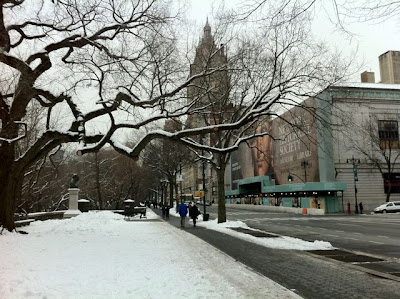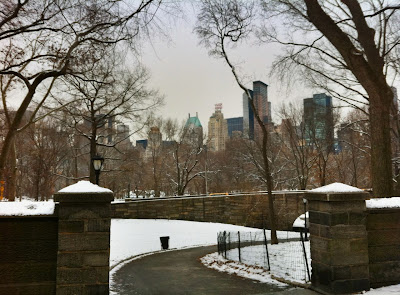A stroll along
Central Park West works well for those who like their walks straight and uncomplicated, their architecture on the theatrical Art Deco side, and their nature decorated with seasonal beauty and well-designed artifice.
 |
Central Park West, looking south. Central Park is on the left (east),
with the New York Historical Society (under wraps for renovation) on the right (west), near W. 77th St.
|
This walk, from the northwest corner of the park at 110th Street straight down to W. 59th Street - the entire west side of Central Park - emphasizes the theatrics of the architecture. (Images below shows sites from north to south in sequence.) Many of the apartment buildings along the way share a resemblance to the theatrical Art Deco movie palaces of the 1930s, especially the twin-towered apartment buildings of the Century and the Majestic (by architect Irwin Chanin), the San Remo (Emery Roth), and Eldorado (Roth and the firm of Margon and Holder). It's not surprising that several entertainers live in these buildings, but the well-reported incident from a few years ago of one apartment building turning down Madonna as a resident underscores the presence of old-school and publicity-shy New Yorkers.
 |
| Now 455 Central Park West Condominiums, at W. 106th St. Formerly New-York Cancer Hospital, and later Towers Nursing Home. built 1884-1886. French architectural influence, like castles of the Loire Valley. |
 |
The Eldorado. 1929-1930 by Emery Roth, consultant
and the firm of Margon and Holder. Fanciful Art Deco touches
|
 |
247-249 Central Park West.
Charming Queen Anne houses from 1888 by architect Edward L. Angell. |
The original New York luxury apartment building, the gorgeous Dakota Apartments (1880-1884), most associated now with the life and death of John Lennon, is on the street at the intersection with 72nd Street. While walking the street look also for lesser-known buildings such as 241 Central Park West and The Kenilworth, each with intriguing stylized details or elaborate entrance ways. Many more buildings, including several houses of worship and the vast American Museum of Natural History, hold their own on these rich blocks, presenting different design styles for an audience of interested pedestrians.
 |
241 Central Park West.
Cool stylized ears of corn on the facade of this Art Deco apartment, 1930-1931. |
 |
| Romanesque structure of the American Museum of Natural History |
In his book
Why Architecture Matters
(Yale University Press, 2009), architecture critic Paul Goldberger writes of the street, "One of the best streets in New York is Central Park West, which is far better than the stretch of Fifth Avenue that faces it across Central Park." (215). The street shows differences among architectural expressions, but there's a consensus about the overall look: "For more than a hundred years, their architects honored the unspoken agreement to work together, to line their buildings up with each other and to work in a consistent scale and with materials that are compatible." (216) As a result, Goldberger argues, Central Park West succeeds in illustrating the most important principle of urban design - "the whole is more than the sum of its parts." (219).
 |
| view of Central Park near W. 77th St. |
 |
| entrance to The Kenilworth, 1908. |
Walking along the park side of Central Park West offers good views of the buildings but also affords the straight-on seasonal views of the park. The varying terrains of the park landscape look great under a few inches of snow, although the park tends to shine no matter what the season. There's no reason not to slip through a park gate here and there just to get a dose of its seasonal glories. As anyone who is lucky enough to have a friend with a Central Park West apartment can attest, the views of the park are just too beautiful.
 |
| entrance to San Remo Apartments, 1929-1930 |
 |
| The Dakota Apartments, 1880-1884. Henry J. Hardenbergh, architect. |
 |
| Central Park, view of the south side from Central Park West |
The length of Central Park is 2.5 miles, so the walk from 110th to 59th or vice-versa, is a good measure for any New York-centered walking plan. Walking from north to south makes some sense as the area near
Columbus Circle at W. 59th Street at the end of the walk offers many opportunities for après-walk food and beverages.
More details and additional buildings in the embedded map:
View Central Park West in a larger map
Images by Walking Off the Big Apple from the wintery afternoon of January 8, 2011, with the iPhone 4 (some with the Pro HDR app, useful for bright contrasts in snowy conditions).
 (Yale University Press, 2009), architecture critic Paul Goldberger writes of the street, "One of the best streets in New York is Central Park West, which is far better than the stretch of Fifth Avenue that faces it across Central Park." (215). The street shows differences among architectural expressions, but there's a consensus about the overall look: "For more than a hundred years, their architects honored the unspoken agreement to work together, to line their buildings up with each other and to work in a consistent scale and with materials that are compatible." (216) As a result, Goldberger argues, Central Park West succeeds in illustrating the most important principle of urban design - "the whole is more than the sum of its parts." (219).
(Yale University Press, 2009), architecture critic Paul Goldberger writes of the street, "One of the best streets in New York is Central Park West, which is far better than the stretch of Fifth Avenue that faces it across Central Park." (215). The street shows differences among architectural expressions, but there's a consensus about the overall look: "For more than a hundred years, their architects honored the unspoken agreement to work together, to line their buildings up with each other and to work in a consistent scale and with materials that are compatible." (216) As a result, Goldberger argues, Central Park West succeeds in illustrating the most important principle of urban design - "the whole is more than the sum of its parts." (219).















Comments
Post a Comment